When can puppies eat wet food? Are you wondering when your adorable little puppy can start munching on wet food? It’s a big step for both of you! Puppies grow up so fast, and their diet is super important to keep them healthy and happy.
Wet food is yummy and packed with good stuff that helps puppies grow strong. Let’s talk about when puppies can switch from drinking milk to eating tasty, wet food. This will be easy to understand, so you’ll know exactly how to help your furry friend during meal times.
What is Wet Food for Puppies?
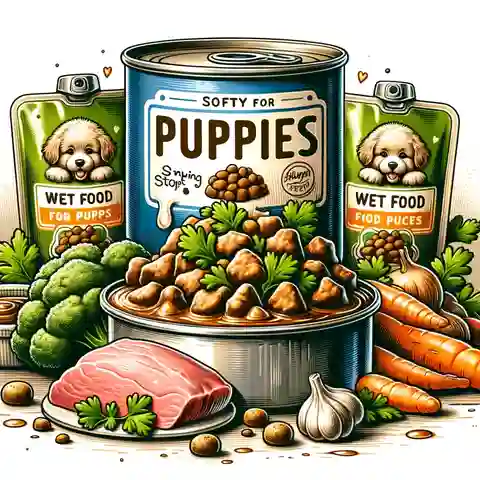
Wet food for puppies is soft, moist dog food that comes in cans or pouches. It’s specially formulated to be easy to eat and digest for young pups. This type of food is often more appealing to puppies because of its texture and flavor, making meal times something they look forward to.
When Can Puppies Eat Wet Food?

Puppies are ready to start trying wet food at about 4 to 6 weeks of age. During this time, they begin the transition from their mother’s milk to solid food.
Why is Wet Food Recommended for Puppies?
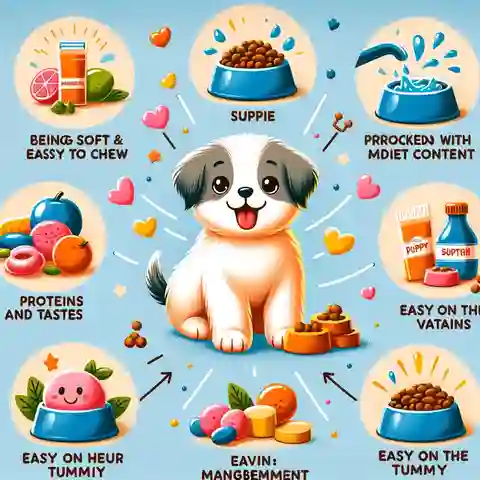
Wet food is great for puppies because it’s easy to chew and swallow. It also helps keep them hydrated because it has a lot of water in it. Here is why wet food is recommended:
Soft and Yummy
First up, puppies are just learning to eat food that’s not their mom’s milk. Their tiny teeth might find hard food tough to chew. But wet food? It’s soft and super easy to eat. Perfect for little pups starting to eat all by themselves.
Keeps Them Watered
Puppies need lots of water to stay healthy and happy. Wet food is like a drink and meal in one because it’s full of moisture.
Packed with Good Stuff
Wet food is full of proteins and vitamins that puppies need to grow big and strong. It’s also made in a way that keeps all the yummy flavors and important nutrients right there in the food, making it really good for your puppy’s health.
Smells and Tastes Great
Puppies have a super sense of smell, and wet food smells amazing to them. If a puppy is picky about food, the smell and taste of wet food might make them want to eat more. This helps them get all the nutrients they need to grow.
Easy on Tummies
Wet food is not just easy to eat; it’s also easy to digest. This is important for puppies because their tummies are still getting used to new foods.
Fun to Eat
Wet food comes in different textures and flavors, which is great for puppies.
Helps With Weight
For puppies who need to watch their weight, wet food can be really helpful. It makes them feel full faster because of all the water in it. This means they might eat less and stay at a healthy weight.
Wet food is great for puppies. But remember, it’s important to choose good quality wet food made just for puppies. And if you’re ever unsure about what to feed your puppy, always ask a vet for advice. They’ll know what’s best for your furry little friend.
How Do You Introduce Wet Food to a Puppy’s Diet?
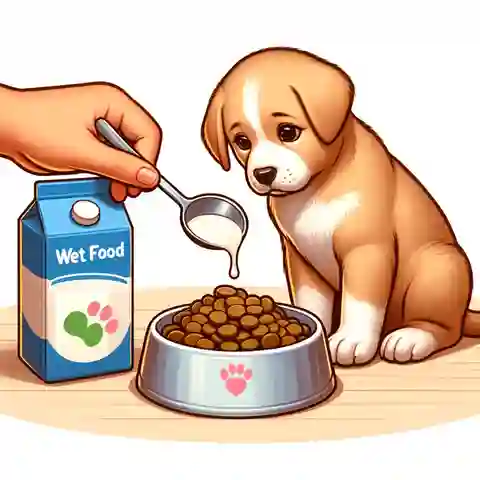
Start by mixing a little bit of wet food with their milk or water. Gradually, you can give them more wet food and less milk until they are eating only wet food.
What Are the Signs That a Puppy is Ready for Wet Food?
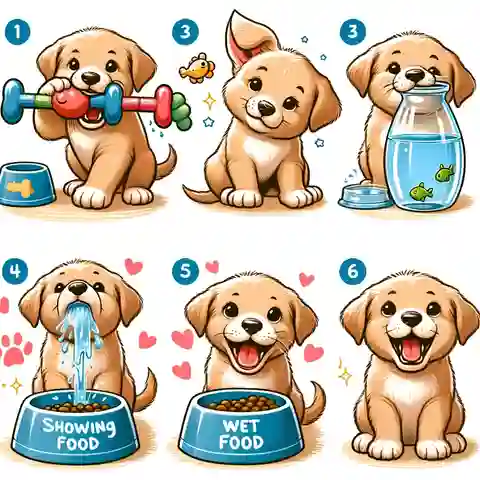
Wondering if your little furball is ready to start trying wet food? There are some clear signs:
Chewing on Everything
Have you noticed your puppy chewing on toys, shoes, or even your fingers? This could be their way of exploring and saying they’re ready to chew on something more filling, like wet food.
Showing Interest in Your Food
If your puppy watches you eat and seems really interested in your food, it’s a good sign they’re ready to try new things. Puppies get curious about different smells and tastes as they grow.
Can Drink Water on Their Own
When puppies can lap up water from a bowl, they’re getting good at controlling their tongue.
Starting to Grow Teeth
Puppies start to get their baby teeth at around 3 to 6 weeks old. When you see those tiny teeth popping up, it’s a sign they might be ready to start on wet food.
Looking Hungry After Milk Feeding
Even after they’ve had their milk, some puppies still seem hungry. This could mean they’re ready for something more satisfying, like wet food, to fill their little bellies.
Good to Know
Every puppy is different. Some might be ready for wet food a bit earlier or later than others. The best start is to introduce wet food slowly into their diet, mixing it with a little bit of water or puppy milk at first.
And here’s a pro tip: always pick high-quality wet food that’s made especially for puppies. It has all the right nutrients they need to grow up healthy and strong.
If you’re ever unsure or have questions about when to start wet food, your vet is the best person to ask.
How Often Should Puppies Eat Wet Food?
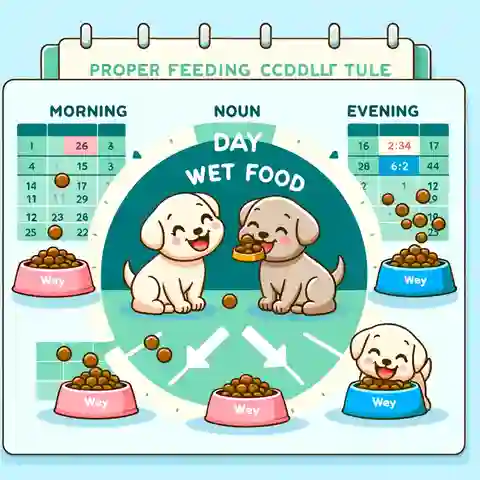
In the beginning, puppies need to eat about three to four times a day. As they get older, you can feed them twice a day.
The Best Wet Food Options for Puppies
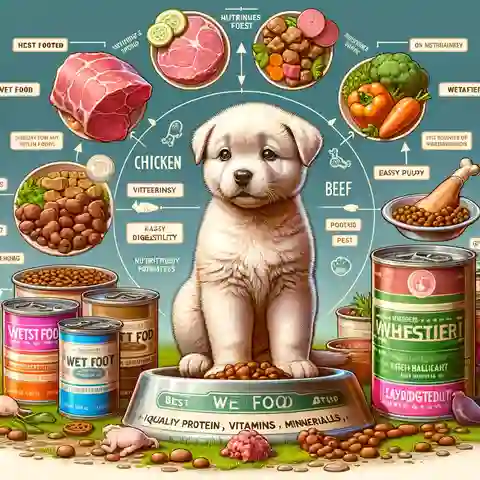
Picking the right wet food for your puppy is super important. You want to make sure they’re getting all the good stuff they need to grow up healthy and strong. Here are some tips on choosing the best wet food for your little friend.
Look for Puppy-Specific Recipes
First off, always look for wet food that’s made just for puppies. Puppy food has the right balance of nutrients like proteins, fats, and vitamins that young dogs need. It’s like picking a kids’ meal that’s got all the healthy bits they need to grow.
High-Quality Protein is Key
Protein is super important for puppies because it helps them build strong muscles. Look for wet food that lists real meat, like chicken, beef, or lamb, as the first ingredient. This means the food is packed with the protein your puppy needs.
Check for Vitamins and Minerals
Puppies need lots of vitamins and minerals to help their bones and teeth grow strong. Choose wet food that’s enriched with things like calcium and phosphorus. These are like the building blocks for a healthy puppy body.
Easy on the Tummy
Since puppies have sensitive tummies, it’s a good idea to pick wet food that’s easy to digest. Foods with pumpkin, sweet potato, or rice can be gentle on their digestive system and help keep their tummy happy.
Avoid Artificial Stuff
Try to pick wet food that doesn’t have artificial colors, flavors, or preservatives. You want everything your puppy eats to be as natural and healthy as possible.
Ask Your Vet
If you’re not sure which wet food to choose, your vet can help. They know all about puppy nutrition and can suggest the best food for your puppy’s age, breed, and health.
Some Popular Puppy Wet Food Brands
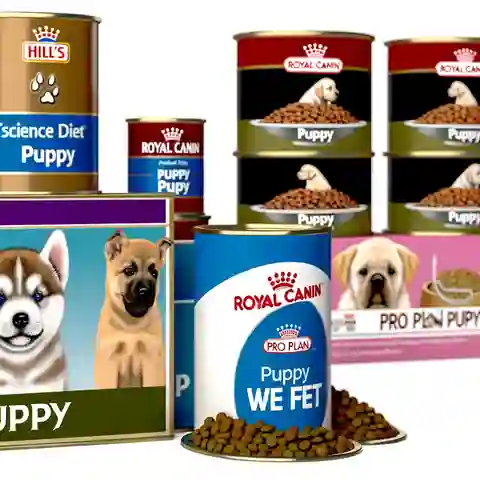
While it’s always good to do your own research and talk to your vet, here are a few brands that many puppy parents like:
- Hill’s Science Diet Puppy: Known for its high-quality ingredients and balance of nutrients.
- Royal Canin Puppy Wet Food: Tailored for puppies’ specific needs with a focus on supporting their growth and development.
- Purina Pro Plan Puppy: Offers a variety of formulas to suit different dietary needs, including sensitive stomach options.
Mixing It Up
Some puppies like a bit of variety in their diet. It’s okay to mix different types of wet food, as long as they’re all suitable for puppies. Just make sure to introduce new foods slowly to avoid upsetting their tummy.
With the right food, your puppy will have everything they need to grow into a happy, healthy dog. Remember, when in doubt, your vet’s advice is gold.
Can Puppies Eat Wet Food Exclusively?
Yes, puppies can eat only wet food, but it’s a good idea to introduce dry food too. This helps them get used to different types of food.
How Wet Food Affects a Puppy’s Growth
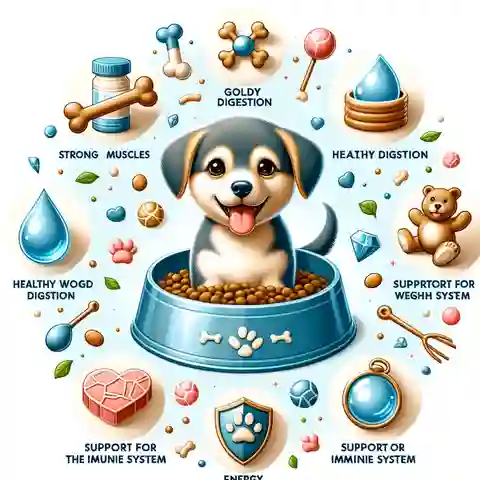
Feeding your puppy wet food can have a big impact on their growth and overall health. Let’s break down how wet food helps your puppy grow up strong and healthy.
- Strong Muscles and Bones
Wet food is packed with high-quality proteins from meats like chicken, beef, or fish. The right balance of calcium and phosphorus in wet food helps your puppy develop strong bones and teeth.
- Healthy Digestion
Because wet food is moist and soft, it’s easier for puppies to chew and digest. This means their little tummies can break down the food better and absorb all the good nutrients they need to grow. Foods with added veggies can also provide fiber, which helps keep their digestion smooth and trouble-free.
- Good Hydration
Staying hydrated is super important for puppies, and wet food has a lot of water in it. This helps make sure your puppy gets enough fluids every day, which is good for their kidneys and overall health.
- Energy to Play and Learn
Puppies are full of energy and always ready to play and learn. The fats and carbohydrates in wet food give them the fuel they need to be active and happy. It’s like filling up their tank for a big day of adventures.
- Supports a Healthy Immune System
Wet food is often rich in vitamins and minerals that support a puppy’s immune system. This means they’re better at fighting off germs and staying healthy. It’s like giving your puppy a shield to keep them safe from sickness.
- Helps with Healthy Weight Gain
Growing puppies need the right amount of calories to grow at a healthy pace. Wet food can be a great way to make sure your puppy is getting enough to eat without overfeeding them. Since it’s filling and satisfying, it can help prevent overeating and keep your puppy at a healthy weight.
- Shiny Coat and Healthy Skin
The oils and fats in wet food are good for your puppy’s skin and coat. They help make sure your puppy’s fur is shiny and soft and that their skin is healthy.
What Should You Do If a Puppy Doesn’t Like Wet Food?
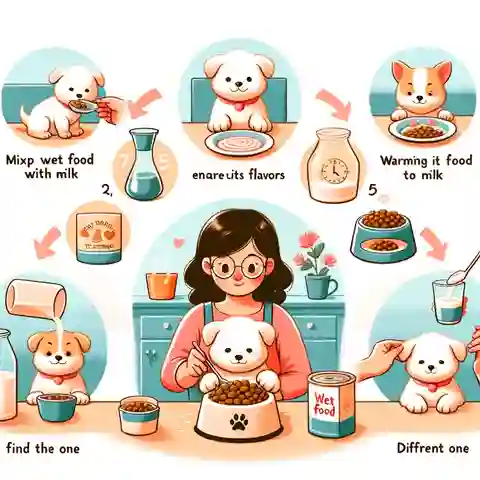
Sometimes, puppies might turn up their noses at wet food. Here are some tips to help your puppy start enjoying their wet food:
- Mix It Up: Try mixing a small amount of wet food with their usual milk or water. Gradually increase the amount of wet food and decrease the milk or water until they’re eating the wet food on its own.
- Warm It Up: Warming the wet food can make it smell and taste better. A little warmth can make the food more appealing to your puppy.
- Try Different Flavors: Just like people, puppies have their own tastes. If they don’t like one flavor, try another.
- Be Patient: Sometimes, puppies need a little time to get used to new foods. Keep offering the wet food and give them time to explore it at their own pace.
- Consult Your Vet: If your puppy refuses to eat wet food or any food at all, it’s a good idea to talk to your vet.
Are There Any Risks Associated with Feeding Puppies Wet Food?
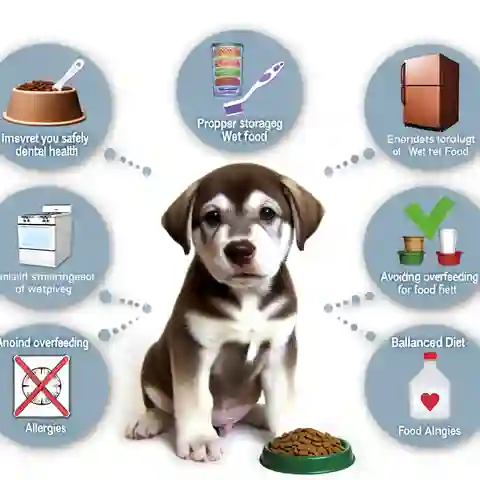
It is generally safe, but there are a few things to keep in mind to make sure your puppy stays healthy:
- Dental Health: Wet food doesn’t help clean teeth as dry food does. To help keep your puppy’s teeth clean, you might want to mix in some dry food or give them dental chews.
- Proper Storage: Once you open a can or pouch of wet food, it needs to be stored in the fridge if not used up and used within a couple of days to prevent spoilage.
- Overfeeding: It can be easy to overfeed with wet food because it’s more dense and less filling than dry food. Make sure to follow the feeding guide on the package or ask your vet how much your puppy should eat.
- Balance Diet: Ensure the wet food you choose is complete and balanced for puppies.
- Food Allergies: Some puppies might be allergic to ingredients commonly found in wet foods. If you notice signs of an allergy (like itching, red skin, or stomach upset), talk to your vet.
How to Store Wet Food for Puppies?
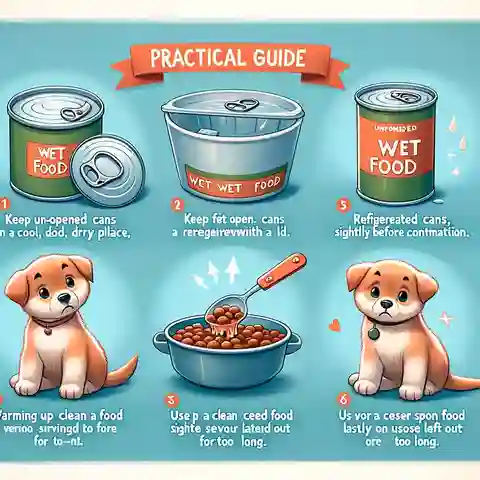
Storing wet food properly is important to keep it fresh and safe for your puppy to eat. Here’s how you can do it:
- Unopened Cans or Pouches: Keep them in a cool, dry place. A pantry or a cupboard works fine. You don’t need to refrigerate them until they’re opened.
- After Opening: Once you open a can or pouch, if there’s food left over, you should cover it and store it in the refrigerator. It’s best to use it within 2-3 days.
- Serving: If the refrigerated wet food is too cold, your puppy might not like it. You can warm it up a little by putting the food in a microwave-safe dish and warming it for a few seconds. Just make sure to stir it and check the temperature to ensure it’s not too hot.
- Avoid Contamination: Use a clean spoon or scoop to take food out of the container.
- Discard Unused Food: If wet food has been left out for more than 4 hours, it’s best to throw it away to avoid the risk of foodborne illness.
When Should You Transition?
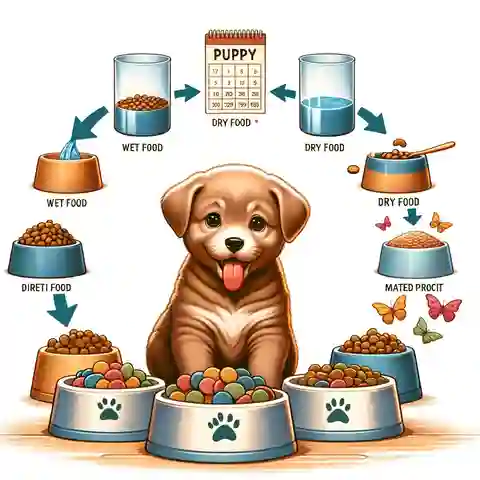
You can start mixing in dry food with wet food when your puppy is around 3 to 4 months old. This helps them get used to dry food slowly. Here’s when and how to do it:
- Age Consideration: The transition usually starts when puppies are around 3 to 4 months old. This is when they can chew nicely and are more capable of digesting dry food.
- Gradual Transition: To switch from wet to dry food, begin by mixing a little dry food with their wet food. Gradually raise the quantity of dry food and reduce the wet food over a week or two.
- Monitor Your Puppy: Watch reactions to the new food. Some puppies might take a bit longer to adjust, while others switch with no problem.
- Why Make the Switch?: Dry food is good for your puppy’s teeth and might be more economical in the long run. It also has a longer shelf life once the bag is opened compared to wet food.
- Hydration is Key: When feeding dry food, make sure your puppy has plenty of fresh water available. Dry food doesn’t have the moisture content that wet food does, so staying hydrated is extra important.
- Consult Your Vet: If you need help deciding the transition or which dry food to choose, your vet can offer personalized advice based on your puppy’s health, breed, and dietary needs.
Can All Breeds of Puppies Eat the Same Type of Wet Food?
When it comes to puppies, not all breeds have the same dietary needs. While many can enjoy the same types of wet food, there are a few things to consider:
- Size Matters: Large breed puppies, like German Shepherds or Great Danes, have different nutritional needs compared to small breeds, like Chihuahuas or Pomeranians. Large breeds need food that supports healthy bone growth to prevent joint problems later in life.
- Energy Levels: High-energy breeds might need food with more calories to keep up with their needs, while less active breeds might need less to avoid weight gain.
- Special Diets: Some breeds might be prone to certain health issues and require special diets. For example, some breeds might need food that’s formulated to support skin and coat health or digestion.
Always check the packaging to see if the food is a good fit for your puppy’s breed and stage of life.
What to Look for When Buying Wet Food for Puppies?
Choosing the right wet food for your puppy is crucial. Here’s what to keep an eye out for:
- Complete and Balanced: Look for foods that are labeled as “complete and balanced.” This means the food provides all the nutrients your puppy needs to grow and thrive.
- High-Quality Protein: Protein is essential for your puppy’s growth. Look for foods with real meat (like chicken, beef, or fish) listed as the first ingredient.
- Age Appropriate: Make sure the food is specifically formulated for puppies. Puppy food has the right nutrients for growing dogs, while adult dog food doesn’t meet these needs.
- Breed Size: If available, choose food that’s tailored to your puppy’s expected adult size (small, medium, large, or giant breed).
- No Artificial Additives: Avoid foods with artificial colors, flavors, or preservatives.
- Vet Recommended: Foods that are recommended by veterinarians or have a veterinary approval stamp can be a good choice.
- Customer Reviews: Reading reviews from other puppy owners can give you insight into how well the food is received by other puppies.
- Allergy Considerations: If your puppy has allergies or a sensitive stomach, look for foods that are hypoallergenic or made with limited ingredients to avoid common allergens.
In conclusion, feeding your puppy wet food is a wonderful choice for their early stages of life. It’s soft, delicious, and packed with the nutrients they need to thrive. But picking the right wet food is key. Make sure it’s high-quality and puppy-specific, with lots of proteins and vitamins to support their growth.
Starting with wet food? Do it gradually. Mix a little with their current diet and increase the amount slowly. This way, their little tummies get used to it without any upset.
It’s easy to overfeed with wet food because it’s so tasty! So, follow the feeding guide or ask your vet for advice.
Puppies are all different. They grow at different rates and have their likes and dislikes. That’s why it’s super important to observe your puppy and adjust their diet as needed.
If your puppy isn’t keen on wet food, try different flavors or warm it up a bit. Does it still need to be fixed? Your vet can help figure out why and suggest other options.



